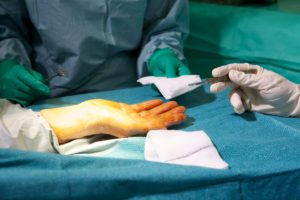Hand Procedures Offered by Dr Damon Thomas

The hands are one of the most important parts of our body. Without them, our quality of life would be lowered significantly. It’s only when medical conditions begin to afflict the hands that many individuals begin to understand their value and fortunately Dr Damon Thomas offers a variety of hand procedures that restore their natural function. Whether you’ve sustained an injury due to congenital defect or trauma, hand surgery and other procedures can help you regain the qualities that you rely upon so heavily.
Paediatric hand surgery
Most hand conditions that arise in young children are due to congenital defects and we consider it very important that children receive corrective surgery so that they may experience a good quality of life from a young age. Paediatric hand surgery targets varying conditions that a child may have, including syndactyly (webbed digits), polydactyly (extra digits), symbrachydactyly (missing digits) and thumb hypoplasia (underdeveloped thumbs).
Toe to hand transfer
A toe to hand transfer is a procedure used to replace a missing finger or thumb in order to make the hand more functional and aesthetically pleasing. The toe functions in the same way as a natural finger and is able to grip and contract. This procedure is ideal for those who have lost a digit or thumb due to injury or illness and typically uses the great or second toe.
Dupuytren’s disease
Dupuytren’s disease is characterised by fingers that bend toward the palm of the hand and remain stuck. The condition occurs when the fibrous tissue in the palm thickens, causing the fingers to bend as if a cord is pulling them downward. Surgery can be performed that reduces the consistency of the tissue but other less invasive methods are also available. Collagenase injections can be used to break up the tissues causing the disease.
Carpal tunnel syndrome
Carpal tunnel is one of the most common conditions to afflict the hands. It appears by causing numbness in the median nerve, which is located in the upper arm. When pressure is placed onto the median nerve, the traditional symptoms of carpal tunnel occur. To alleviate symptoms, surgery is often performed that relieves the pressure on the nerve and restores function and sensation to the hand.
Obstetric brachial plexus palsy
Obstetric brachial plexus palsy most commonly occurs during the birthing process when the baby’s shoulder gets lodged in the birth canal. When the nerves between the neck and shoulder become damaged, palsy can occur that effects the normal functioning of the hand. Reconstructive surgery and physiotherapy are often suggested in order to help patients regain function in the arm. Without correcting the condition, a child can have muscle weakness, a lack of mobility or trouble feeling varying temperatures.
If you or your child are currently suffering from any of the above hand conditions, it’s important you consult with a physician. For more information about what Dr Thomas can do to restore function to your hands, please contact our office on (03) 9508 9508.
MAKING AN INFORMED DECISION
Our website is intended to provide general information about hand surgery and should not be used as a substitute for personalised medical advice. It is important to consult with a qualified plastic surgeon to determine if hand surgery is the right procedure for you. The following considerations should be part of your decision-making process.
Risks
All surgical procedures carry risk. The potential risks and complications associated with hand surgery include, but are not limited to, bleeding, infection, nerve damage, stiffness, loss of feeling or movement of the hand or fingers, scarring, and the need for additional surgery. It is important to understand the risks involved and weigh up the benefits and drawbacks of surgery before undergoing hand surgery.
Recovery
Recovery time after hand surgery may vary depending on the individual, the extent of the procedure, and the technique used. In general, patients should be prepared to experience some discomfort, swelling, and limited mobility after surgery. Patients must also be prepared to take time off work and other activities (including exercise) and follow post-operative instructions to promote proper healing and minimise the risk of complications.
Results
Individual results may vary depending on a number of factors, including the patient’s natural hand structure, the patient’s lifestyle, and the surgical technique employed. It is critical to have realistic expectations about the outcome of hand surgery and understand that each patient’s outcome will be unique. A physical therapy rehabilitation program after hand surgery is often crucial to regain function and improve range of motion.
If you have any questions or concerns about hand surgery, please do not hesitate to contact us.
